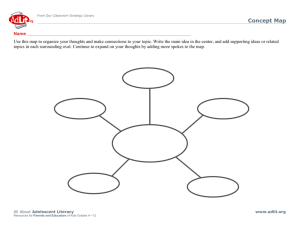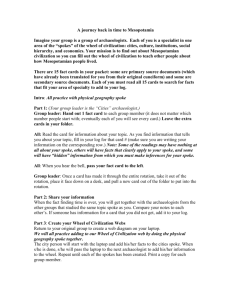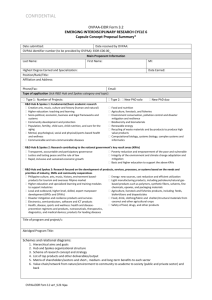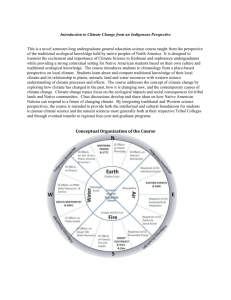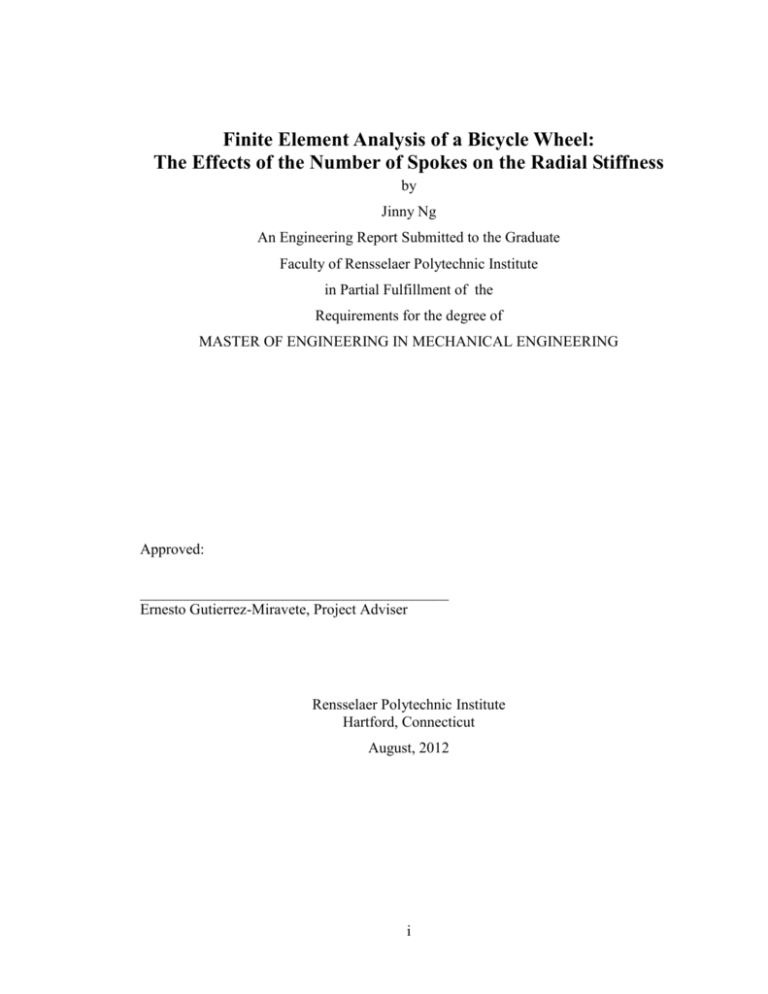
Finite Element Analysis of a Bicycle Wheel:
The Effects of the Number of Spokes on the Radial Stiffness
by
Jinny Ng
An Engineering Report Submitted to the Graduate
Faculty of Rensselaer Polytechnic Institute
in Partial Fulfillment of the
Requirements for the degree of
MASTER OF ENGINEERING IN MECHANICAL ENGINEERING
Approved:
_________________________________________
Ernesto Gutierrez-Miravete, Project Adviser
Rensselaer Polytechnic Institute
Hartford, Connecticut
August, 2012
i
© Copyright 2012
by
Jinny Ng
All Rights Reserved
ii
CONTENTS
Finite Element Analysis of a Bicycle Wheel: The Effects of the Number of Spokes on
the Radial Stiffness ....................................................................................................... i
LIST OF TABLES ............................................................................................................ iv
LIST OF FIGURES ........................................................................................................... v
NOMENCLATURE ......................................................................................................... vi
ACKNOWLEDGMENT ................................................................................................. vii
ABSTRACT ................................................................................................................... viii
1. Introduction/Background ............................................................................................. 1
2. Methodology and Approach ........................................................................................ 4
3. Results and Discussions ............................................................................................... 8
4. Conclusion ................................................................................................................. 15
5. References.................................................................................................................. 16
Appendix A...................................................................................................................... 17
iii
LIST OF TABLES
Table 1. Spoke and Rim Material and Mechanical Properties. ......................................... 4
Table 2. Spoke and Rim Geometries. ................................................................................ 5
Table 3. Pretension for each bicycle wheel model. ........................................................... 6
Table 4. Displacements for 28, 32 and 36-spoked bicycle wheels. ................................... 9
iv
LIST OF FIGURES
Figure 1. Antiquated wheels [1] and a modern bicycle wheel [2]. .................................... 1
Figure 2. Tension of a bicycle wheel spoke [4]. ................................................................ 1
Figure 3. 2 mm straight gage spoke [4]. ............................................................................ 5
Figure 4. Rim cross section defined in Abaqus/CAE. ....................................................... 5
Figure 5. Loads and boundary conditions on a 36-spoked bicycle wheel created in
Abaqus/CAE. ..................................................................................................................... 7
Figure 6. (Left to right) Stress plots of the 28, 32 and 36-spoked wheels at 100 times
magnification. .................................................................................................................. 10
Figure 7. (Left to right) Compressive stresses of the rim for 28, 32 and 36-spoked wheels
at 100 times magnification............................................................................................... 11
Figure 8. Plots of spoke tension and change in spoke tension for a 28-spoked wheel. ... 12
Figure 9. Plots of spoke tension and change in spoke tension for a 32-spoked wheel. ... 13
Figure 10. Plots of spoke tension and change in spoke tension for a 36-spoked wheel. . 14
v
NOMENCLATURE
E
Young's Modulus (psi)
ν
Poisson's Ratio
vi
ACKNOWLEDGMENT
I would like to thank Professor Ernesto Gutierrez-Miravete for his guidance throughout
the completion of my master’s project. I would also like to thank my colleagues for
sharing their knowledge in the ABAQUS software. Lastly, I would like to thank my
family and friends for their support throughout my entire academic career.
vii
ABSTRACT
The purpose of this investigation is to evaluate the effects that the number of spokes
have on the radial stiffness of a bicycle wheel. For this investigation, three bicycle
wheels with 28, 32, and 36 radial spokes were modeled as two dimensional nonlinear
static stress models using a finite element analysis (FEA) software. These wheels were
subjected to a radial load only. The stresses, forces and displacements of each model
were compared to determine the relationship between the number of spokes and the
radial stiffness of the wheel. Based on the FEA results, the radial stiffness increased with
increasing number of spokes, as expected. The stresses and forces in the spokes and the
displacements of the bottom spoke decreased as more spokes were added to the wheel.
Additionally, the pretensioned lower spokes had reduced in tension while the rest of the
spokes slightly increased in tension. The behavior of the bicycle wheel models validated
the works of Whitt and Wilson, and Burgoyne and Dilmaghanian.
viii
1. Introduction/Background
The wheel is a load carrying device which has facilitated the transportation of goods and
people. The circular form of the wheel is used in many machinery applications today
such as gears and pulleys. The bicycle is a vehicle that utilizes wheels and is a good
example of how wheels have evolved over centuries to more sophisticated designs. A
bicycle wheel consists of wire spokes radiating outward from the hub, located at the
center of the wheel, to the rim where the spokes are fastened to by threaded spoke
nipples.
Figure 1. Antiquated wheels [1] and a modern bicycle wheel [2].
Prior to the invention of the wire-spoked wheel, carriages and wagons had thick
wooden-spoked wheels that were able to resist compressive loads. Around the middle of
the nineteenth century [3], wire-spoked wheels replaced wooden wheels due to their
lightweight quality, durability and strength (see Figure 1). However, unlike their wooden
counterparts, wire spokes are not compressible structures and therefore, would buckle
under compression. To overcome this obstacle, the wire spokes are prestressed in
tension so that a compressive load would result in a reduction of pretension (see Figure
2).
Figure 2. Tension of a bicycle wheel spoke [4].
1
Many factors, such as the number of spokes, spoke and rim materials, and spoke patterns
contribute to the stiffness and overall strength of a bicycle wheel [5]. The stiffness of a
bicycle wheel has three components: radial, lateral and tangential (torsional) stiffness.
The radial stiffness resists radial deflections of the rim; the lateral stiffness resists
sideways deflections; and the torsional stiffness resists the torque that rotates the hub to
propel the bicycle forward [5].
For this project, the effect that the number of spokes has on the radial stiffness of a
bicycle wheel was evaluated using FEA. The numbers of radial spokes considered for
this investigation are 28, 32, and 36. The spoke pattern, which is defined by the number
of times a spoke crosses other spokes, is zero-cross (0x) or radial-spoked for all three
models. The three models are subjected to a radial load only. The stresses, forces and
displacements of each model were compared to determine the relationship between the
different spoke numbers and the radial stiffness of the wheel.
Others have performed analyses to study the behavior of a bicycle wheel. According to
Whitt and Wilson (cited in Reference (3)), they concluded the following:
“Under load, a spoked wheel takes up not an oval shape, as is often stated, but an
approximately circular shape with a flattened portion in the vicinity of road
contact…. In the spoked wheel, the increased compressive stress in the rim
increases the tension of all spokes except those in the (slightly) flattened region,
where the spoked tension naturally decreases. The load on the axle is taken, then
by the combined effect of the increased spoke tension at the top of the wheel and
the decreased tension in the region of contact. All other spokes have
approximately equal tension and balance each other.”
Burgoyne and Dilmaghania reported that their test results broadly verified Pippard’s
analysis of spokes as pre-stressing elements [3]. They stated that the rim does not carry
a majority of the load. The rim serves as a reaction system for the pretensioned spokes
so that the spokes can support large compressive loads before they buckle. Additionally,
2
the rim bends locally to distribute the loads to the spokes. The bottom spokes do most of
the work so the displacements are greater than those of the rest of the spokes [3]. This
corresponds to an increasing compression in the rim [3].
3
2. Methodology and Approach
Three bicycle wheels (28, 32, and 36 radial-spoked wheels) were modeled as two
dimensional structures using the FEA software Abaqus/CAE. The wire spokes, hub and
rim were the only structural parts considered for this investigation. The other parts of
the wheel, such as the axle, bearings and tire, do not play a role in affecting the wheel’s
stiffness [5]. In the finite element models, the spokes and rim were created as one part
using deformable wires in three dimensional space. Additionally, the hub was not
modeled, to further simplify the analysis. Instead the spokes were pinned in the x, y, and
z directions where the hub and spoke would meet.
The materials, mechanical properties, and geometric dimensions of the spoke and rim
are summarized in Tables 3 and 4. The spoke material is 304 Stainless Steel. The type
of spoke used for this analysis is a 2 mm straight gage spoke (see Figure 3). The spoke
cross section is modeled as a circle and is assumed to be constant through the length of
spoke. The cross section of the rim used was a hollow box with dimensions taken from
Reference (6) (see Figure 4). The rim material is 6061-T6 Aluminum Alloy. These rim
and spoke materials are commonly used to manufacture bicycle wheels.
Bicycle Wheel
Parts
Spokes
Rim
Mechanical Properties
Young's Modulus, E Poisson's Ratio,
(ksi)
ν
10,000 [7]
0.29 [7]
Material
304 Stainless Steel
6061-T6
Aluminum Alloy
28,000 [7]
Table 1. Spoke and Rim Material and Mechanical Properties.
4
0.33 [7]
Geometry
Bicycle Wheel Parts
Profile
Diameter (in)
Cross-Sectional Area
(in2)
Spokes
Circle
0.07874 (2 mm) [4]
0.004869
Rim
Box
Hub
N/A
22 (wheel diameter) [4];
See Figure 4 for other
dimensions
2
0.1271
N/A
Table 2. Spoke and Rim Geometries.
Figure 3. 2 mm straight gage spoke [4].
Figure 4. Rim cross section defined in Abaqus/CAE.
The elements used to model the rim and spokes are linear 2-noded cubic beam elements
(B33) and linear 2-noded three dimensional truss elements (T3D2), respectively. The
truss elements can only support axial loads and therefore, are appropriate for modeling
the spokes [8]. For all models, there are 10 truss elements along the length of the spokes
5
and four beam elements along the rim in between each spoke. A mesh refinement study
was performed to confirm that it was unnecessary because it did not affect the results.
The type of analysis used in Abaqus/CAE was a nonlinear static stress analysis. The
analysis is divided into two steps. The first step is to pretension the spokes. The second
step is to apply the radial load.
The loads applied to the bicycle wheel models are pretension and radial loads as shown
in Figure 5. Bolt preload was added to each spoke to model the pretension. The value
of the bolt preload varied for each model since it depended on the number of spokes (see
Table 3). The total pretension was the same for each wheel. It was arbitrarily taken as
the average of the recommended values in Reference (9) and multiplied by 28 spokes
(approximately 6500 lbf). As for the radial load, the weight of an average human male
(196 lbf [10]) was applied on the bottom rim as an upward force from the ground. Since
only one wheel is modeled, the radial force is half of the weight (98 lbf).
Model
Total Pretension (lbf)
28 spokes
32 spokes
36 spokes
6500
6500
6500
Pretension Per Spoke
(lbf)
232
203
181
Table 3. Pretension for each bicycle wheel model.
The boundary conditions of the models are as follows: (1) the spokes at the hub end are
pinned in the three orthogonal directions (UX=UY=UZ=0); and (2) the wheels are
constrained in the XY plane to avoid out of plane bending (UZ=0). An example is
shown in Figure 5.
6
Figure 5. Loads and boundary conditions on a 36-spoked bicycle wheel created in Abaqus/CAE.
7
3. Results and Discussion
The results (stresses, forces and displacements) for each wheel were compared to
observe the effect of increasing spoke number on the radial stiffness of a bicycle wheel.
In Figure 6, the stresses on the spokes decreased as more spokes are added to the wheel.
In the 28-spoked wheel, the stresses on the spokes range from 33,590 psi to 48,760 psi.
In the 32-spoked wheel models, the stresses on the spokes range from 31,080 psi to
42,720 psi. Both of these models have three bottom spokes supporting the compressive
load. In the 36-spoked wheel model, the rim distributed the load to five bottom spokes.
The range of stresses for the 36-spoked wheel is 27,000 psi to 37,950 psi. Similarly, the
compressive stresses in the rim decreased with increasing number of spokes (see Figure
7).
For all the wheels, the bottom spokes are less stressed than the rest of the spokes (see
Figure 6). In other words, the spokes near the ground reduced in tension while the
remainder slightly increased in tension. This is shown in Figures 8, 9, and 10, which
plot the spoke tension due to preload against the spoke tension due to an additional load
(radial load). The change in tension (difference between tension due to preload and
tension due to a radial load) decreased with increasing number of spokes. Consequently,
the more spokes added to a wheel, the greater its radial stiffness becomes.
Another observation shown in Figure 6 is the deformation of all three bicycle wheels,
scaled at 100 times magnification. The wheels have a circular shape with some local
deformation near the ground, which is in good agreement with Whitt and Wilson’s
conclusion. The maximum vertical displacements occur at the bottom node where the
radial load was applied (refer to Figure 5). The maximum vertical displacements of the
bottom node decrease with increasing number of spokes (see Table 4). As a result, the
radial stiffness increases because there are more spokes resisting the radial load. Table 4
also shows that the displacements due to preload are similar because the total pretension
is the same for all the wheels. The displacements due to a radial load are small in
comparison with the preload since the radial load is not as large as the pretension.
8
Model
Pretension Per
Spoke (lbf)
Total Displacement
of Bottom Node
(in)
28 spokes
32 spokes
36 spokes
232
203
181
0.0131937
0.0127661
0.0124327
Displacement of
Bottom Node
Due To Preload
(in)
0.00913748
0.00906571
0.0090276
Displacement of
Bottom Node Due
to a Radial Load
(in)
0.00405622
0.00370039
0.0034051
Table 4. Displacements for 28, 32 and 36-spoked bicycle wheels.
As part of the model checks, the sum of the reaction forces was taken at the center of
wheel. The forces due to the radial load were approximately equal to 98 lbf. The forces
due to preload added up to approximately zero lbf (refer to the Appendix A).
9
Figure 6. (Left to right) Stress plots of the 28, 32 and 36-spoked wheels at 100 times magnification.
There are three observations to make here: (1) As more spokes are added to the wheel, the stresses in the spokes decrease because there are more spokes
supporting the compressive load; (2) In all the models, the lower spokes (not colored in red) are less stressed than the rest of the other spokes. The lower spokes
have a reduced in tension while the remainder experience additional tension; (3) In all the models, the wheels have local deformation near the ground while
maintaining an approximately circular shape.
10
Figure 7. (Left to right) Compressive stresses of the rim for 28, 32 and 36-spoked wheels at 100 times magnification.
The plots show the compressive stresses for all three models as a result of the pretensioned spokes pulling the rim inward. For all the wheels, the maximum
stresses in the rim occur at where it connects to the spokes. From left to right, the stresses decrease in the rim at where it connects to the spokes. This
observation corresponds to the first observation made in Figure 6 where the spoke stresses decreased with more spokes added to the wheel.
11
Figure 8. Plots of spoke tension and change in spoke tension for a 28-spoked wheel.
(Top left) The data points for spokes 1, 2 and 28 are located below the preload line (colored in blue), which means that these spokes have reduced tension.
Meanwhile the rest of the spokes have additional tension. (Bottom left) The reduced tension in spokes 1, 2 and 28 is represented negative here.
12
Figure 9. Plots of spoke tension and change in spoke tension for a 32-spoked wheel.
(Top left) The tension in spokes 1, 2 and 32 are reduced (their data points are located below the preload line). The tension in spokes 3 and 31 are the same as the
preload line and therefore, experience no change in tension. The rest of the spokes have additional tension. (Bottom left) The reduced tension in spokes 1, 2 and
28 is represented negative here. The change in tension in spokes 3 and 31 are nearly zero. The additional tension in the other spokes is represented positive.
13
Figure 10. Plots of spoke tension and change in spoke tension for a 36-spoked wheel.
(Top left) The tension in spokes 1, 2, 3, 35 and 36 are reduced (their data points are located below the preload line). The rest of the spokes have additional
tension. (Bottom left) Negative change in tension means reduced in tension (see spokes 1, 2, 3, 35 and 36). A positive change in tension represents additional
tension (see spokes 4 through 34).
14
4. Conclusion
This FEA project showed that the increasing number of spokes on a bicycle wheel
increased the radial stiffness, as expected. The stresses and forces in the spokes and the
displacements of the bottom spokes decreased as more spokes were added to the wheel.
There were more spokes supporting the compressive load as well as resisting the load.
The behavior of the 28, 32, and 36-spoked bicycle wheel models were in good
agreement with the works of Whitt and Wilson, and Burgoyne and Dilmaghanian. The
models deformed locally at the point of contact with the ground while the rest of the
wheel maintained a circular shape. Additionally, the lower spokes had reduced in tension
while the rest of the spokes slightly increased in tension.
15
5. References
1. Peloubet, Don. “Wheelmaking: Wooden Wheel Design and Construction.” Astragal
Press, 1996.
2. Bicycle Wheel. "Bicycle Wheel" Wikipedia: The Free Encyclopedia. Wikimedia
Foundation, Inc. 2 July 2012, 4 Jul. 2012,
<http://en.wikipedia.org/wiki/Bicycle_wheel>
3. Burgoyne, C.J. & R. Dilmaghanian. “Bicycle Wheel as Prestressed Structure.”
Journal of Engineering Mechanics 119 (3). (1993): 439-455. Pdf.
4. Wheelbuilder. Spoke Selection, 2012. Web. July 2012
<http://www.wheelbuilder.com/store/spoke-selection.html>
5. Brandt, Jobst. The Bicycle Wheel, Third Edition. Avocet, Inc., Palo Alto, California
1981.
6. Bicycle Wheel Analysis. <http://www.astounding.org.uk/ian/wheel/index.html>
7. MatWeb Material Property Data. <http://www.matweb.com/>
8. Hartz, Andrew D. Finite Element Analysis of the Classic Bicycle Wheel. July 2002.
<http://www.rose-hulman.edu/~fine/FE2002/Projects/Hartz.pdf>
9. Parker Tool, TM-1 Tension Meter, Accessed on 7/15/12,
<http://www.parktool.com/product/spoke-tension-meter-TM-1>
10. Body Weight. "Body Weight" Wikipedia: The Free Encyclopedia. Wikimedia
Foundation, Inc. 2 July 2012, 22 Jul. 2012,
<http://en.wikipedia.org/wiki/Body_weight>
16
Appendix A
Microsoft Excel sheets used to create the plots shown in Figures 8, 9 and 10.
28-Spoked Wheel:
Spoke Number
1
2
3
4
5
6
7
8
9
10
11
12
13
14
15
16
17
18
19
20
21
22
23
24
25
26
27
28
RF, Magnitude (lbf)
Due to Preload
Due to Radial Load
232.143
177.092
232.143
210.828
232.143
234.85
232.143
237.02
232.143
234.985
232.143
234.266
232.143
234.31
232.143
234.397
232.143
234.413
232.143
234.407
232.143
234.404
232.143
234.404
232.143
234.404
232.143
234.404
232.143
234.404
232.143
234.404
232.143
234.404
232.143
234.404
232.143
234.404
232.143
234.407
232.143
234.413
232.143
234.397
232.143
234.31
232.143
234.266
232.143
234.985
232.143
237.02
232.143
234.85
232.143
210.828
Difference
-55.051
-21.315
2.707
4.877
2.842
2.123
2.167
2.254
2.27
2.264
2.261
2.261
2.261
2.261
2.261
2.261
2.261
2.261
2.261
2.264
2.27
2.254
2.167
2.123
2.842
4.877
2.707
-21.315
sum of forces
17
RF2 (Y direction) (lbf)
Due to Preload Due to Radial Load
232.143
177.092
226.323
205.539
209.154
211.585
181.497
185.3
144.739
146.5
100.723
101.633
51.6566
52.1284
5.78E-12
-9.42E-03
-51.6566
-52.1696
-100.723
-101.712
-144.739
-146.153
-181.497
-183.267
-209.154
-211.192
-226.323
-228.527
-232.143
-234.404
-226.323
-228.527
-209.154
-211.192
-181.497
-183.267
-144.739
-146.153
-100.723
-101.712
-51.6566
-52.1696
-5.40E-12
-9.42E-03
51.6566
52.1284
100.723
101.633
144.739
146.5
181.497
185.3
209.154
211.585
226.323
205.539
0
-98.00123126
32-Spoked Wheel:
Spoke Number
1
2
3
4
5
6
7
8
9
10
11
12
13
14
15
16
17
18
19
20
21
22
23
24
25
26
27
28
29
30
31
32
RF, Magnitude (lbf)
Due to Preload Due to Radial Load
203.125
152.874
203.125
180.228
203.125
203.364
203.125
207.693
203.125
206.147
203.125
205.053
203.125
204.881
203.125
204.966
203.125
205.017
203.125
205.023
203.125
205.019
203.125
205.016
203.125
205.016
203.125
205.016
203.125
205.016
203.125
205.016
203.125
205.016
203.125
205.016
203.125
205.016
203.125
205.016
203.125
205.016
203.125
205.016
203.125
205.019
203.125
205.023
203.125
205.017
203.125
204.966
203.125
204.881
203.125
205.053
203.125
206.147
203.125
207.693
203.125
203.364
203.125
180.228
RF2 (Y direction) (lbf)
Due to Preload Due to Radial Load
-50.251
203.125
152.874
-22.897
199.222
176.763
0.239
187.663
187.878
4.568
168.892
172.683
3.022
143.631
145.761
1.928
112.85
113.913
1.756
77.7325
78.3964
1.841
39.6277
39.9789
1.892
2.14E-07
-7.21E-03
1.898
-39.6277
-40.0042
1.894
-77.7325
-78.4622
1.891
-112.85
-113.905
1.891
-143.631
-144.971
1.891
-168.892
-170.466
1.891
-187.663
-189.411
1.891
-199.222
-201.077
1.891
-203.125
-205.016
1.891
-199.222
-201.077
1.891
-187.663
-189.411
1.891
-168.892
-170.466
1.891
-143.631
-144.971
1.891
-112.85
-113.905
1.894
-77.7325
-78.4622
1.898
-39.6277
-40.0042
1.892
2.17E-07
-7.21E-03
1.841
39.6277
39.9789
1.756
77.7325
78.3964
1.928
112.85
113.913
3.022
143.631
145.761
4.568
168.892
172.683
0.239
187.663
187.878
-22.897
199.222
176.763
sum of forces
4.31382E-07
-98.00261432
18
Difference
36-Spoke Wheels:
Spoke Number
1
2
3
4
5
6
7
8
9
10
11
12
13
14
15
16
17
18
19
20
21
22
23
24
25
26
27
28
29
30
31
32
33
34
35
36
RF, Magnitude (lbf)
RF2 (Y direction) (lbf)
Difference
Due to Preload Due to Radial Load
Due to Preload Due to Radial Load
180.556
134.294
-46.262
180.556
134.294
180.556
156.804
-23.752
177.813
154.421
180.556
178.557
-1.999
169.667
167.785
180.556
184.518
3.962
156.366
159.792
180.556
183.744
3.188
138.314
140.75
180.556
182.487
1.931
116.059
117.294
180.556
182.061
1.505
90.278
91.0238
180.556
182.07
1.514
61.7538
62.265
180.556
182.14
1.584
3.14E+01
3.16E+01
180.556
182.168
1.612
1.69E-07
-5.69E-03
180.556
182.17
1.614
-31.3533
-31.6385
180.556
182.166
1.61
-61.7538
-62.3087
180.556
182.164
1.608
-90.278
-91.0855
180.556
182.164
1.608
-116.059
-117.095
180.556
182.164
1.608
-138.314
-139.548
180.556
182.164
1.608
-156.366
-157.76
180.556
182.164
1.608
-169.667
-171.179
180.556
182.164
1.608
-177.813
-179.397
180.556
182.164
1.608
-180.556
-182.164
180.556
182.164
1.608
-177.813
-179.397
180.556
182.164
1.608
-169.667
-171.179
180.556
182.164
1.608
-156.366
-157.76
180.556
182.164
1.608
-138.314
-139.548
180.556
182.164
1.608
-116.059
-117.095
180.556
182.164
1.608
-90.278
-91.0855
180.556
182.166
1.61
-61.7538
-62.3087
180.556
182.17
1.614
-3.14E+01
-3.16E+01
180.556
182.168
1.612
1.71E-07
-5.69E-03
180.556
182.14
1.584
31.3533
31.622
180.556
182.07
1.514
61.7538
62.265
180.556
182.061
1.505
90.278
91.0238
180.556
182.487
1.931
116.059
117.294
180.556
183.744
3.188
138.314
140.75
180.556
184.518
3.962
156.366
159.792
180.556
178.557
-1.999
169.667
167.785
180.556
156.804
-23.752
177.813
154.421
sum of forces
3.40057E-07
-97.99918581
19

